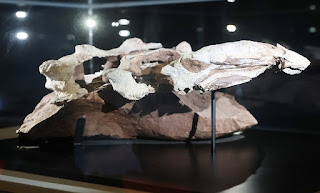After unearthing two specimens in Jiangxi Province, eastern China, researchers have bestowed the name "Datai yingliangis" upon a newly identified armored dinosaur species. This designation pays homage to the locality of discovery and individuals involved in the find, marking a significant contribution to the paleontological record.
The unearthing of this newfound dinosaur represents a notable enrichment of the Ankylosaurine fossil record, a group known for its iconic armored features during the early Late Cretaceous period. Xing Lida, an associate professor at China University of Geosciences, Beijing (CUGB), emphasizes the significance of this discovery.
It not only expands our understanding of Ankylosaurines but also sheds light on the evolutionary dynamics of these remarkable creatures during a pivotal period in Earth's history.
Both specimens, identified as subadults, boasted a body length ranging from 3.5 to 4 meters each. Notably, both individuals exhibited a distinctive feature—a pair of characteristic horns adorning their cheeks.
This observation provides valuable insights into the anatomical characteristics and growth patterns of this newly identified armored dinosaur species, adding further depth to our understanding of its morphology and developmental stages.
The examination of the third and fourth cervical vertebrae of these dinosaurs revealed an intriguing detail: both vertebrae bore evidence of being penetrated by two curved cave remains, each approximately 2 centimeters in diameter.
This finding suggests a potentially significant aspect of the dinosaurs' lives, hinting at encounters or behaviors that left distinct marks on their skeletal remains. Further analysis of these cave remains may unveil additional clues about the environment and interactions these dinosaurs experienced during their lifetime.
"These remains typically correspond to cave marks etched into the sediment by mollusks or other invertebrates," explained Xing. "It's plausible that these creatures simply burrowed into the sediment, inadvertently coming into 'close contact' with Datai yingliangis." This insight underscores the intricate ecological interactions and environmental conditions that shaped the lives of these ancient armored dinosaurs.
A fascinating detail emerged during the discovery: the two dinosaurs were found stacked on top of each other, a phenomenon believed to occur due to rapid burial under aeolian sand deposits.
"This peculiar arrangement likely relates to the social behavior of Ankylosaurs," Xing remarked. This observation offers tantalizing clues about the behavior and social dynamics of these armored dinosaurs, hinting at potential group behavior or herd formations among this species. Further study of such discoveries may unravel deeper insights into the lives and habits of these ancient creatures.
The findings from this study have been meticulously documented and published in the esteemed journal Vertebrate Anatomy Morphology Palaeontology, providing a comprehensive account of the discovery and its implications for our understanding of prehistoric life.
This publication ensures that the scientific community and enthusiasts alike can access and scrutinize the research, contributing to ongoing dialogue and advancement in paleontological knowledge.












No comments:
Post a Comment